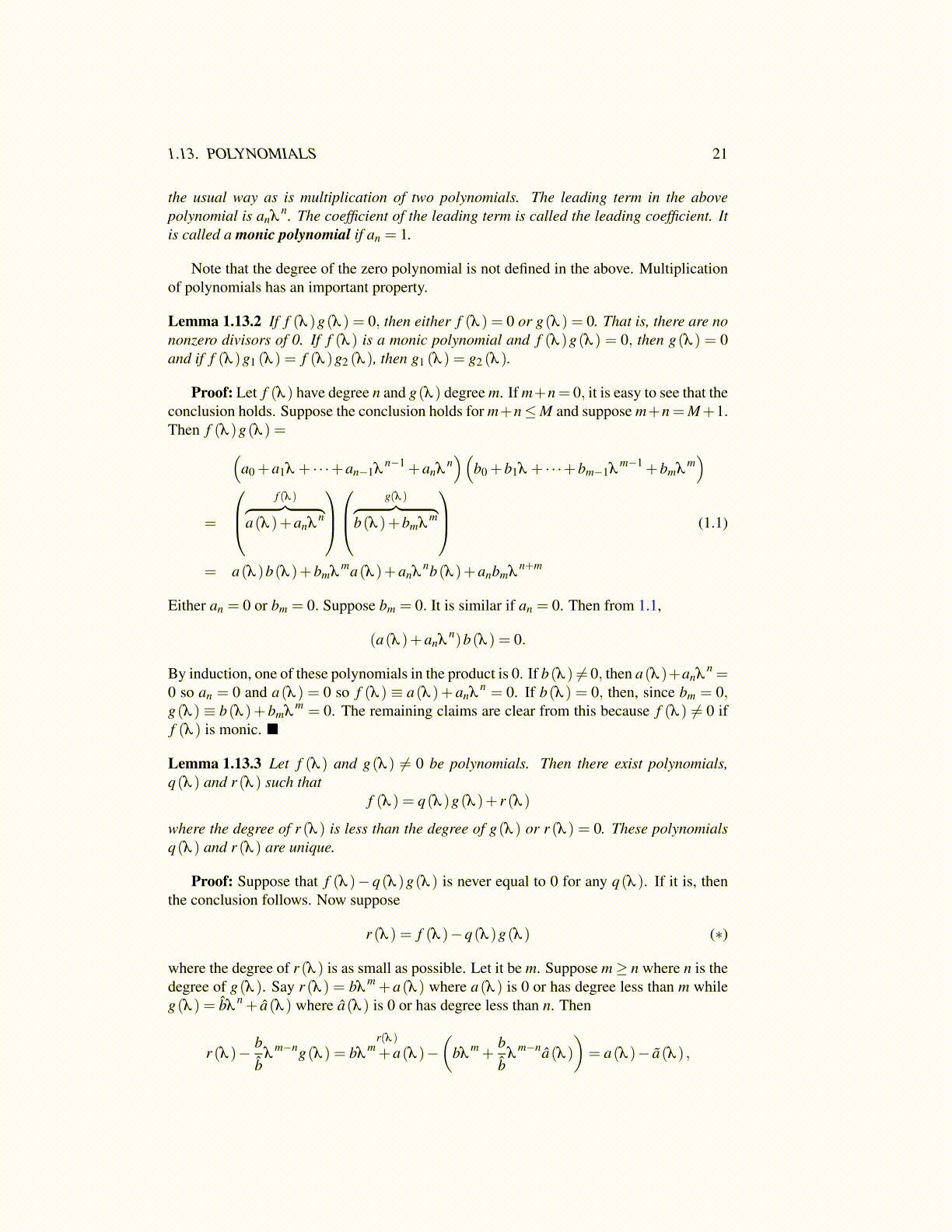
1.13. POLYNOMIALS 21
the usual way as is multiplication of two polynomials. The leading term in the abovepolynomial is anλ
n. The coefficient of the leading term is called the leading coefficient. Itis called a monic polynomial if an = 1.
Note that the degree of the zero polynomial is not defined in the above. Multiplicationof polynomials has an important property.
Lemma 1.13.2 If f (λ )g(λ ) = 0, then either f (λ ) = 0 or g(λ ) = 0. That is, there are nononzero divisors of 0. If f (λ ) is a monic polynomial and f (λ )g(λ ) = 0, then g(λ ) = 0and if f (λ )g1 (λ ) = f (λ )g2 (λ ), then g1 (λ ) = g2 (λ ).
Proof: Let f (λ ) have degree n and g(λ ) degree m. If m+n= 0, it is easy to see that theconclusion holds. Suppose the conclusion holds for m+n≤M and suppose m+n = M+1.Then f (λ )g(λ ) =(
a0 +a1λ + · · ·+an−1λn−1 +anλ
n)(
b0 +b1λ + · · ·+bm−1λm−1 +bmλ
m)
=
f (λ )︷ ︸︸ ︷
a(λ )+anλn
g(λ )︷ ︸︸ ︷b(λ )+bmλ
m
(1.1)
= a(λ )b(λ )+bmλma(λ )+anλ
nb(λ )+anbmλn+m
Either an = 0 or bm = 0. Suppose bm = 0. It is similar if an = 0. Then from 1.1,
(a(λ )+anλn)b(λ ) = 0.
By induction, one of these polynomials in the product is 0. If b(λ ) ̸= 0, then a(λ )+anλn =
0 so an = 0 and a(λ ) = 0 so f (λ ) ≡ a(λ )+ anλn = 0. If b(λ ) = 0, then, since bm = 0,
g(λ ) ≡ b(λ )+bmλm = 0. The remaining claims are clear from this because f (λ ) ̸= 0 if
f (λ ) is monic. ■
Lemma 1.13.3 Let f (λ ) and g(λ ) ̸= 0 be polynomials. Then there exist polynomials,q(λ ) and r (λ ) such that
f (λ ) = q(λ )g(λ )+ r (λ )
where the degree of r (λ ) is less than the degree of g(λ ) or r (λ ) = 0. These polynomialsq(λ ) and r (λ ) are unique.
Proof: Suppose that f (λ )− q(λ )g(λ ) is never equal to 0 for any q(λ ). If it is, thenthe conclusion follows. Now suppose
r (λ ) = f (λ )−q(λ )g(λ ) (∗)
where the degree of r (λ ) is as small as possible. Let it be m. Suppose m≥ n where n is thedegree of g(λ ). Say r (λ ) = bλ
m +a(λ ) where a(λ ) is 0 or has degree less than m whileg(λ ) = b̂λ
n + â(λ ) where â(λ ) is 0 or has degree less than n. Then
r (λ )− bb̂
λm−ng(λ ) =
r(λ )bλ
m +a(λ )−(
bλm +
bb̂
λm−nâ(λ )
)= a(λ )− ã(λ ) ,